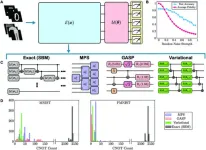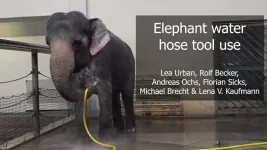(Press-News.org) A recent study by researchers from CSIRO and the University of Melbourne has made progress in quantum machine learning, a field aimed at achieving quantum advantage to outperform classical machine learning. Their work demonstrates that quantum circuits for data encoding in quantum machine learning can be greatly simplified without compromising accuracy or robustness. This research was published Sept.12 in Intelligent Computing, a Science Partner Journal.
The team’s results, validated through both simulations and experiments on IBM quantum devices, show that their innovative encoding methods reduced circuit depth by a factor of 100 on average compared to traditional approaches while achieving similar classification accuracies. The findings offer an exciting new pathway for the practical application of quantum machine learning on current quantum devices. Looking forward, the team aims to scale these models for larger, more complex datasets and explore further optimizations in quantum state encoding and quantum machine learning architecture design.
One of the key obstacles to efficient quantum machine learning has been encoding classical data into quantum states, a computationally challenging task requiring deeply entangled circuits. To overcome this, the team introduced three encoding methods that approximate the quantum state of the data using much shallower circuits. These methods—matrix product state, genetic, and variational algorithms—maintained classification accuracy on the MNIST image dataset and two others while enhancing resilience against adversarial data manipulation.
Each method uniquely approximated quantum state encoding classical data to enable efficient state preparation:
Matrix product state encoding: This approach uses tensor networks to create quantum states that can be sequentially disentangled. This structure allows for quantum states with low entanglement to be prepared with a small number of Controlled-NOT, or CNOT gates, further reducing complexity.
Genetic algorithm for state preparation: Inspired by evolutionary processes, this approach optimizes the state preparation process by generating various circuit configurations, selecting the most efficient, and minimizing the number of CNOT gates, thus making the circuits more resistant to noise.
Variational coding: This method utilizes trainable parameters within a layered circuit structure, allowing for the quantum states to reach a target accuracy in fewer layers. This reduces the need for extensive entangling operations and typically lowers computational costs.
The work aligns with broader goals in quantum machine learning to build efficient, reliable quantum models for areas such as image recognition, cybersecurity, and complex data analysis. The reduction in circuit depth is critical for achieving practical quantum machine learning on current devices, which are often limited by gate fidelity and qubit count. The increased robustness of these models to adversarial attacks opens up new possibilities for secure quantum machine learning applications in sectors where resilience to tampering is essential.
END
New quantum encoding methods slash circuit complexity in machine learning
2024-11-08
ELSE PRESS RELEASES FROM THIS DATE:
New research promises an unprecedented look at how psychosocial stress affects military service members’ heart health
2024-11-08
A University of Massachusetts Amherst researcher will examine the role of cumulative psychosocial stress – as well as race, ethnicity and gender – among U.S. military personnel to gauge their impact on cardiovascular health and healthcare utilization.
The study is funded with a $1 million grant from the Defense Health Agency, part of the Department of Defense (DoD). The findings will help the military develop programs for health promotion and health readiness for active duty and Reserve/National ...
Faster measurement of response to antibiotic treatment in sepsis patients using Dimeric HNL
2024-11-08
The biomarker human neutrophil lipocalin HNL, which was previously shown to be a useful indicator of bacterial infections, may also in the form of Dimeric HNL be used to effectively monitor the success of antibiotic treatment in sepsis. The first promising results in this regard were published in 2019 and now the research group has confirmed these results in a larger study. The study is published in the journal PLOS ONE.
Sepsis, the costliest disease to health care, is a life-threatening condition with high mortality if not diagnosed and ...
Cleveland Clinic announces updated findings in preventive breast cancer vaccine study
2024-11-08
November 8, 2024, CLEVELAND: Cleveland Clinic researchers are presenting updated findings from their novel study of a vaccine aimed at preventing triple-negative breast cancer, the most aggressive and lethal form of the disease.
The study team found that the investigational vaccine was generally well tolerated and produced an immune response in most patients. The team described the side effects of the vaccine, showed the highest tolerated dose to date, and presented the immunologic effects of the vaccine. Findings are being presented at the Society for Immunotherapy of Cancer Annual Meeting.
Launched in 2021 and funded by the U.S. Department of Defense, the ongoing ...
Intergenerational effects of adversity on mind-body health: Pathways through the gut-brain axis
2024-11-08
The Brain & Behavior Research Foundation (BBRF) is hosting a free webinar, “Intergenerational Effects of Adversity on Mind-Body Health: Pathways Through the Gut-Brain Axis” on Tuesday, November 12, 2024, at 2:00 pm ET. The presenter, Bridget Laura Callaghan, Ph.D., is an Assistant Professor in the Department of Psychology at the University of California, Los Angeles (UCLA). At UCLA, Dr. Callaghan directs the Brain & Body Lab in the Department of Psychology and also heads the Mental Disorders and Pain research theme at the Goodman Luskin Microbiome Center. The webinar host, Jeffrey Borenstein, M.D., is the President ...
Watch this elephant turn a hose into a sophisticated showering tool
2024-11-08
Tool use isn’t unique to humans. Chimpanzees use sticks as tools. Dolphins, crows, and elephants are known for their tool-use abilities, too. Now a report in the Cell Press journal Current Biology on November 8, 2024, highlights elephants’ remarkable skill in using a hose as a flexible shower head. As an unexpected bonus, researchers say they also have evidence that a fellow elephant knows how to turn the water off, perhaps as a kind of “prank.”
“Elephants are amazing with hoses,” says Michael Brecht ...
Chimpanzees perform better on challenging computer tasks when they have an audience
2024-11-08
When people have an audience watching them, it can change their performance for better or worse. Now, researchers reporting in the Cell Press journal iScience on November 8 have found that chimpanzees’ performance on computer tasks is influenced by the number of people watching them. The findings suggest that this “audience effect” predates the development of reputation-based human societies, the researchers say.
“It was very surprising to find that chimpanzees are affected in their task performance by ...
New medical AI tool identifies more cases of long COVID from patient health records
2024-11-08
KEY TAKEAWAYS
Researchers from Mass General Brigham are leveraging artificial intelligence to help identify the signs of long COVID, track how different symptoms manifest over time, and eliminate alternative explanations for patients’ symptoms.
The new approach suggests that 22.8% of the population experience the symptoms of long COVID, a figure that may paint a more realistic picture of the pandemic’s long-term toll.
Through analyzing a patient’s history over time, this new AI tool ...
Heat waves and adverse health events among dually eligible individuals 65 years and older
2024-11-08
About The Study: In this time-series study, heat waves were associated with increased adverse health events among dually eligible individuals 65 years and older. Without adaptation strategies to address the health-related impacts of heat, dually eligible individuals are increasingly likely to face adverse outcomes.
Corresponding Author: To contact the corresponding author, Hyunjee Kim, PhD, email kihy@ohsu.edu.
To access the embargoed study: Visit our For The Media website at this link https://media.jamanetwork.com/
(doi:10.1001/jamahealthforum.2024.3884)
Editor’s Note: Please ...
Catastrophic health expenditures for in-state and out-of-state abortion care
2024-11-08
About The Study: In this cross-sectional study of U.S. patients seeking abortion, many individuals and their households were estimated to incur catastrophic health expenditures, particularly those traveling from out of state. The financial and psychological burdens of abortion seeking have likely worsened after the Dobbs decision, as more people need to cross state lines to reach abortion care. The findings suggest expansion of insurance coverage to ensure equitable access to abortion care, irrespective of people’s state of residence, ...
State divorce laws, reproductive care policies, and pregnancy-associated homicide rates
2024-11-08
About The Study: In this cross-sectional study of pregnancy-associated homicide rates, barriers to divorce were associated with higher homicide rates and access to reproductive health care was associated with lower homicide rates. This study highlights the association between state legislation and pregnancy-associated homicide in the U.S., which is important information for policymakers.
Corresponding Author: To contact the corresponding author, Kaitlin M. Boyle, PhD, email kb49@mailbox.sc.edu.
To access the embargoed study: Visit our For The Media website at this link https://media.jamanetwork.com/
(doi:10.1001/jamanetworkopen.2024.44199)
Editor’s ...



